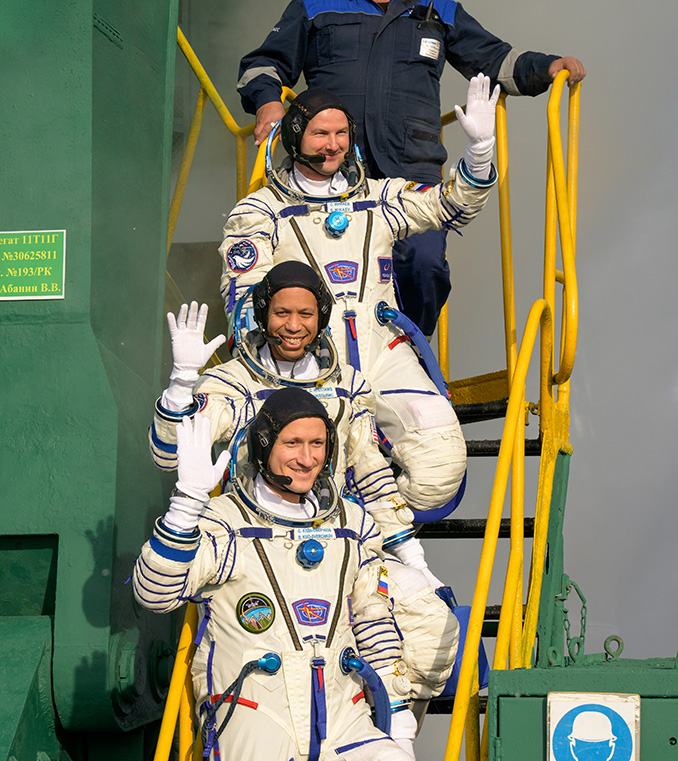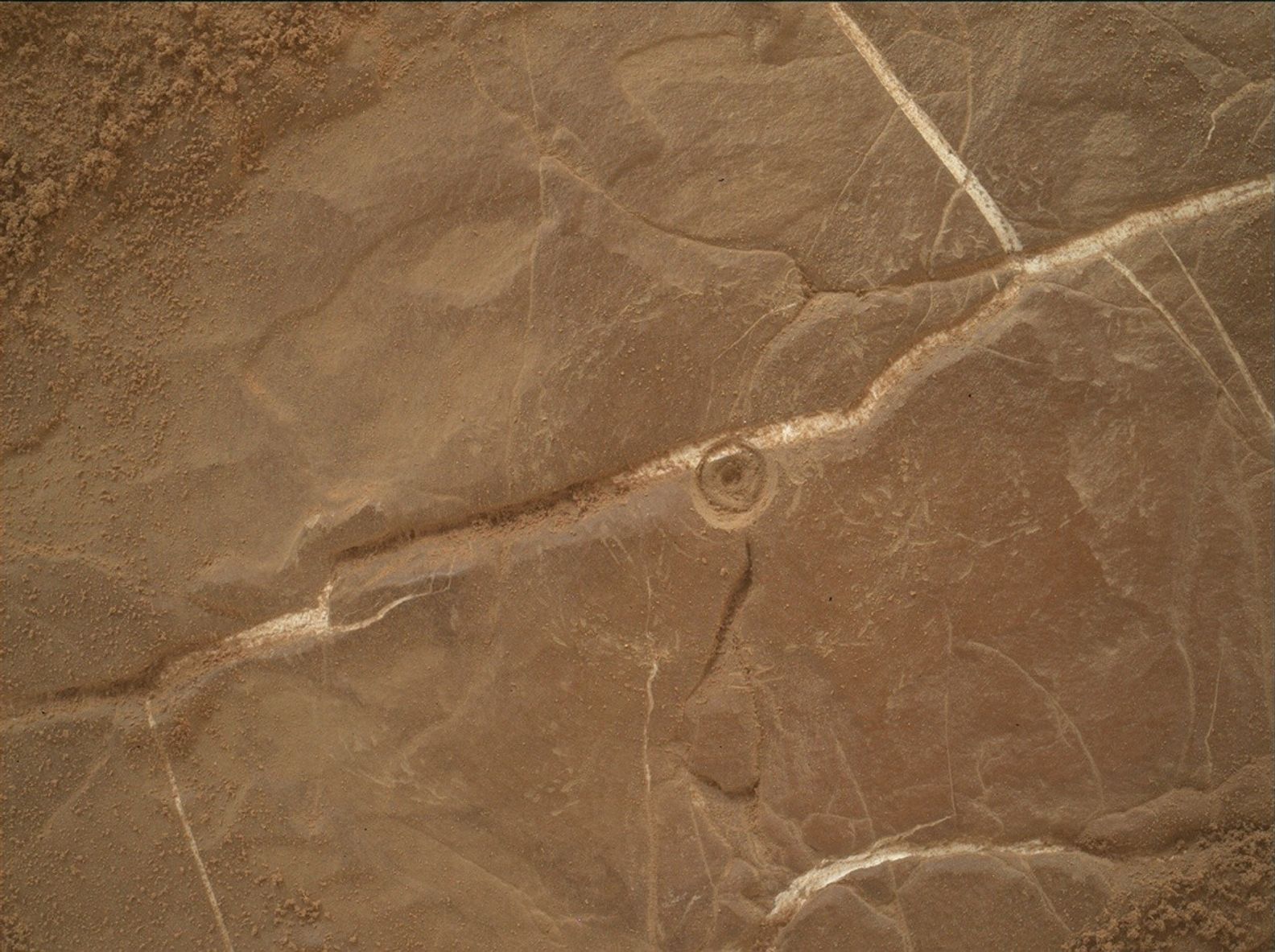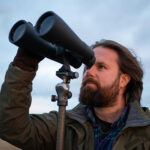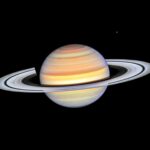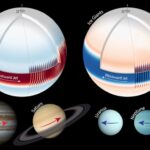Now Reading: Further delays of Starliner’s next flight mark anniversary of its first crewed Space Station docking
-
01
Further delays of Starliner’s next flight mark anniversary of its first crewed Space Station docking
Further delays of Starliner’s next flight mark anniversary of its first crewed Space Station docking
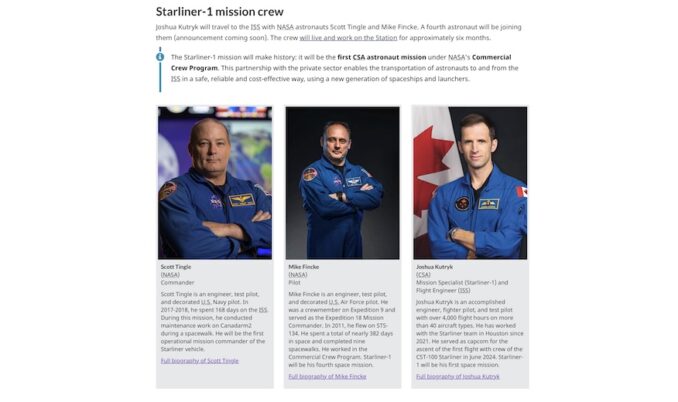

One year ago today, Boeing’s CST-100 Starliner spacecraft docked with the International Space Station to begin its long-awaited Crew Flight Test with NASA astronauts Sunita “Suni” Williams and Barry “Butch” Wilmore onboard.
A year later, the future of the Starliner program remains uncertain as NASA announced late Friday that the next flight of the spacecraft was being delayed from no earlier than late 2025 to now early 2026 at the soonest.
The agency said the timing of the next launch is “pending system certification and resolution of Starliner’s technical issues.” Repeating what it said back in a March 27 press release, NASA said it was still determining whether or not the next flight of Starliner would carry astronauts onboard.
In an interview with Reuters published in late May, Williams called flying an uncrewed Starliner flight as its next trip to space would be “the logical thing to do.”
“I think that’s the correct path,” Williams told Reuters, adding that she hoped “Boeing and NASA will decide on that same course of action.”
After launching on its first mission to the International Space Station with crew on board in June 2024, lingering issues concerning helium leaks and propulsion system anomalies caused the spacecraft to return to Earth without its crew onboard. It touched down at the White Sands Space Harbor in New Mexico on Sept. 7.

Prior to the uncrewed return of Starliner, Wilmore and Williams became part of the Expedition 72 crew onboard the space station and members of the SpaceX Crew-9 mission, which made its return to Earth in March 2025.
Following the landing of Starliner in September 2024, NASA didn’t say much about the vehicle’s next steps until early March during SpaceX Crew-10 briefings. Steve Stich, CCP manager, said on March 7 that NASA and Boeing were still working through corrective actions on the vehicle before they knew what the next flight would look like.
“We’ll continue to work for certification toward the end of this year and try to — whatever we do, the Starliner will be crew capable,” Stich said. “When we look at the manifest for this year, it’s pretty, pretty busy in the fall timeframe… So, we’ve got to go figure out, manifest-wise, where does the Starliner fit? Does it fit best towards the end of this calendar year, the first flight back after CFT, or early next year?”
In the aforementioned March 27 news release, NASA said that the agency and Boeing would be spending the spring and summer at the White Sands Test Facility in New Mexico going through “integrated firing of key Starliner thrusters within a single service module doghouse to validate detailed thermal models and inform potential propulsion and spacecraft thermal protection system upgrades, as well as operational solutions for future flights.”
A “doghouse” is the term used to describe the four compartments on the Starliner’s service module exterior that each house seven Reaction Control System (RCS) thrusters. Five of these RCS thrusters went out during the attempt to rendezvous Starliner with the space station on June 6.
Four of the thrusters were recovered, prior to docking. However, there are still lingering questions about how to either redesign part of the vehicle or operate it in a different fashion such that similar issues don’t happen again.

Spaceflight Now asked NASA for an overview of the schedule of testing out at White Sands, like when it will begin and the timing of milestones. An agency spokesperson said, “We will share more information as work progresses.”
Asked during a Crew-9 post-mission press conference if he would ride on Starliner again, Wilmore said, “Yes.”
“Because we’re going to rectify all of these issues that we encountered. We’re gonna fix ‘em. We’re gonna make it work,” Wilmore said. “Boeing’s completely committed, NASA’s completely committed and with that, I’d get on in a heartbeat.”
In its March 27 statement NASA said it was still determining whether or not crew will be on board the next time Starliner flies, but said that, “Mission managers are planning for the next Starliner flight to be a crew capable post-certification mission.”
“NASA also has the capability of flying only cargo depending on the needs of the agency.”
Who’s on first?
While NASA continues to ponder the question of whether or not crew will be on the next flight of Starliner, question marks continue to swirl around who the astronauts will be that will fly the first crewed mission, dubbed Starliner-1.
There seemed to be a firm answer as recently as last September, when Boeing’s CST-100 Starliner spacecraft returned to Earth without its crew on board. But recently, both NASA and the Canadian Space Agency (CSA), the agencies who previously announced three out of the four astronauts set to fly on the post-certification flight of the spacecraft, dubbed Starliner-1, are now unwilling to back their previous statements.
When the Starliner Crew Flight Test (CFT) mission ended on Sept. 7, 2024, with the spacecraft’s landing in New Mexico, the members of the Starliner-1 mission were known to be NASA Astronauts Scott Tingle and Edward Michael “Mike” Fincke as the commander and pilot respectively. CSA astronaut, Joshua Kutryk was assigned as one of the mission specialists.
The fourth seat was never formally assigned, but there were indications that Japan Aerospace Exploration Agency (JAXA) astronaut Kimiya Yui was training as a mission specialist for that mission.
In a post on X, JAXA astronaut Soichi Noguchi shared a photo taken by Boeing of Yui during the rollout of the Starliner spacecraft ahead of the CFT flight and stated (via Google Translate), “We also have the heroic figure of @Astro_Kimiya who is rumored to be a member of the first operation vehicle #Starliner1! Good luck, Yui-san!”
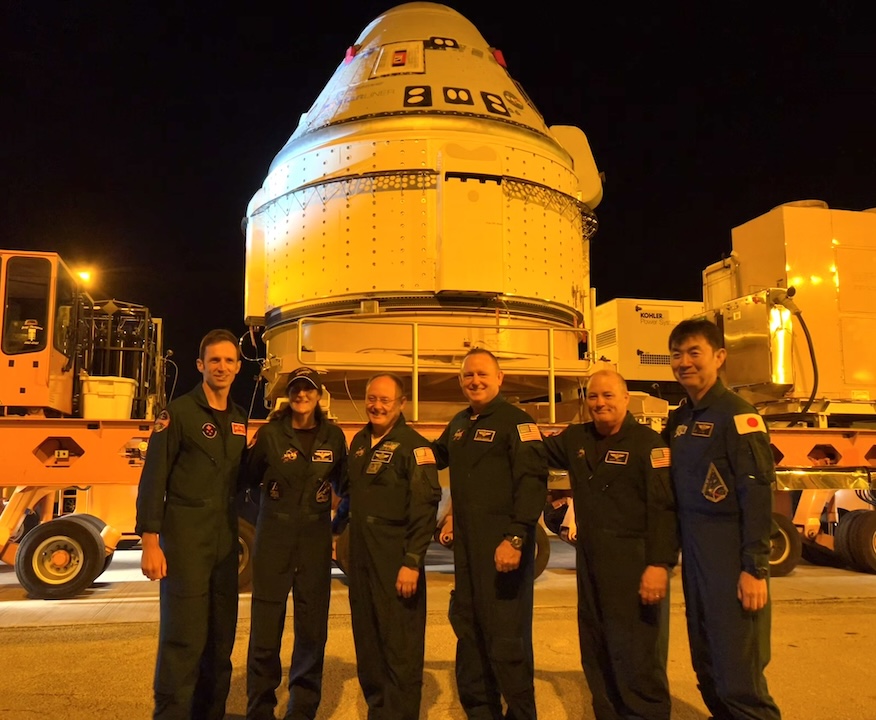
NASA announced a change to the Starliner-1 lineup on March 27 when it named the astronauts and cosmonaut who would be flying the SpaceX Crew-11 mission no earlier than July 2025. Among the four announced were both Fincke and Yui.
“NASA decided to reassign the astronauts to Crew-11 in overall support of planned activities aboard the International Space Station,” the agency wrote. “(Zena) Cardman carries her experience training as a commander on Dragon spacecraft, and Fincke brings long-duration spaceflight experience to this crew complement.”
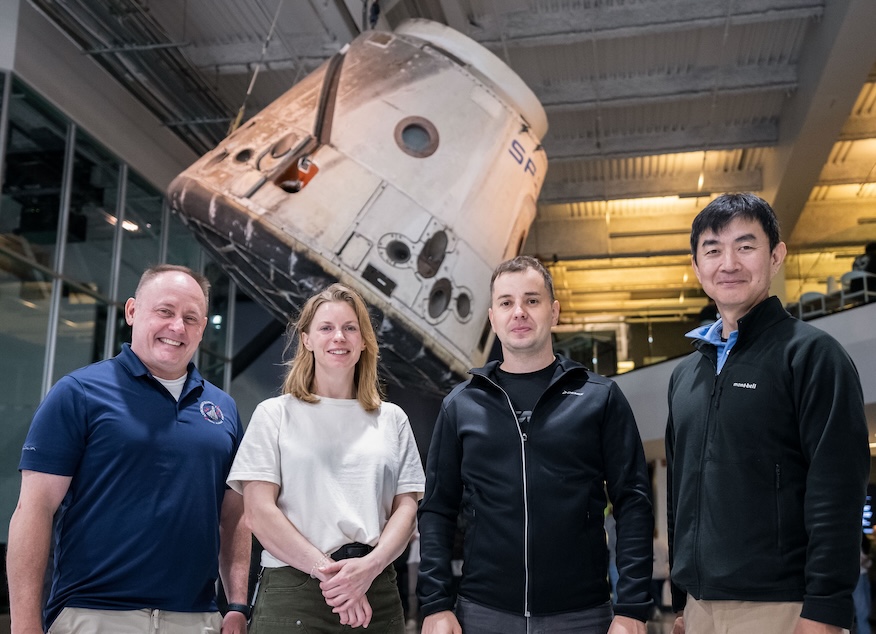
In light of Fincke’s reassignment, Spaceflight Now reached out at to NASA at the time to confirm that Tingle and Kutryk were both still assigned to the Starliner-1 mission. NASA declined to confirm that.
“NASA and its international partners continue to evaluate future assignments based on the crew members’ qualifications, skills, and experience to ensure the respective agencies accomplish their human spaceflight goals,” an agency spokesperson told Spaceflight Now in a statement. “NASA will share additional information on crew assignments when available.”
Asked again, for clarification, if that meant that Tingle and Kutryk were no longer part of the Starliner-1 crew, the spokesperson replied, “We will follow up when we have more information on future crew assignments.”
History of Starliner-1 (abridged)
The trio of Tingle, Fincke, Kutryk (and likely Yui) wasn’t always the makeup of the Starliner-1 mission. Back in 2018, NASA hosted a large event at the Johnson Space Center to unveil the crews who would fly on the demonstration missions for both Boeing’s Starliner spacecraft as well as SpaceX’s Crew Dragon.
Dragon Demo-2 would fly NASA astronauts Bob Behnken and Doug Hurley and Starliner CFT would fly Boeing astronaut Chris Ferguson and NASA astronauts Eric Boe and Nicole Mann.
At the same event, NASA announced which of its astronauts would be flying the first full crew rotation missions. Crew-1 received Victor Glover and Michael Hopkins and Starliner-1 got Joshua Cassada and Suni Williams.
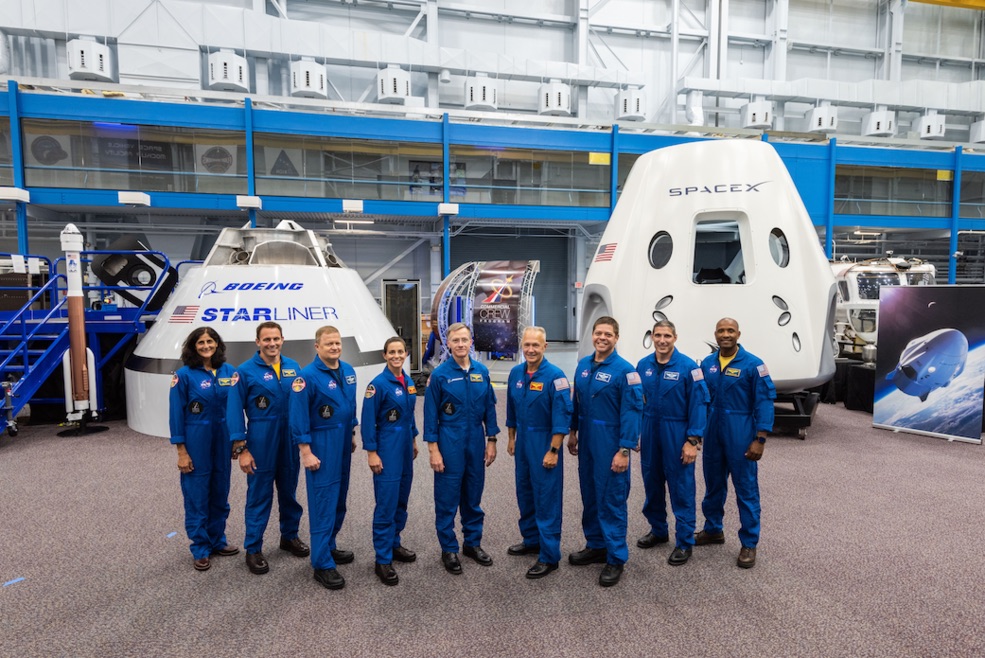
Shortly after the announcement, Fincke replaced Boe on CFT due to medical reasons. Then, in August 2020, NASA astronaut Jeanette Epps was assigned to the Starliner-1 mission.
In October 2020, when Ferguson bowed out from CFT for family reasons, Butch Wilmore was named commander of that mission.
Then, when Starliner had to stand down from launching the Orbital Flight Test 2 (OFT-2) mission in July 2021, that October, NASA announced it was reassigning Mann and Cassada to the SpaceX Crew-5 mission.
“It has been the opportunity of a lifetime to train on a brand-new spacecraft, the Boeing Starliner, and it has been fantastic to work with the Boeing team,” Mann said in a statement. “I am thrilled to have the opportunity to train on another new spacecraft – the SpaceX Crew Dragon – and appreciate the teams at NASA who have made that possible. I am ready to fly and serve on the International Space Station.”
JAXA astronaut, Koichi Wakata, who was also reportedly training for the Starliner-1 mission, was also assigned to the Crew-5 mission.
In May 2022, during a pre-launch press conference before the uncrewed flight of the Starliner Orbital Flight Test 2 (OFT-2), Fincke, Williams and Wilmore were all referred to collectively as a “cadre of Starliner astronauts,” with NASA not explicitly stating who would fly on which mission.
Following the launch of OFT-2, in June 2022, Williams was named pilot of the CFT mission and Fincke was reassigned to be the backup pilot for CFT. Then, in September 2022, NASA named Tingle as the commander of Starliner-1 and announced Fincke would be the pilot on that flight.
On August 4, 2023, NASA announced that Epps was moving off of the Starliner-1 mission to the SpaceX Crew-8 mission. The agency said it made the move “to allow Boeing time to complete development of Starliner while also continuing plans for astronauts to gain spaceflight experience for future mission needs.”
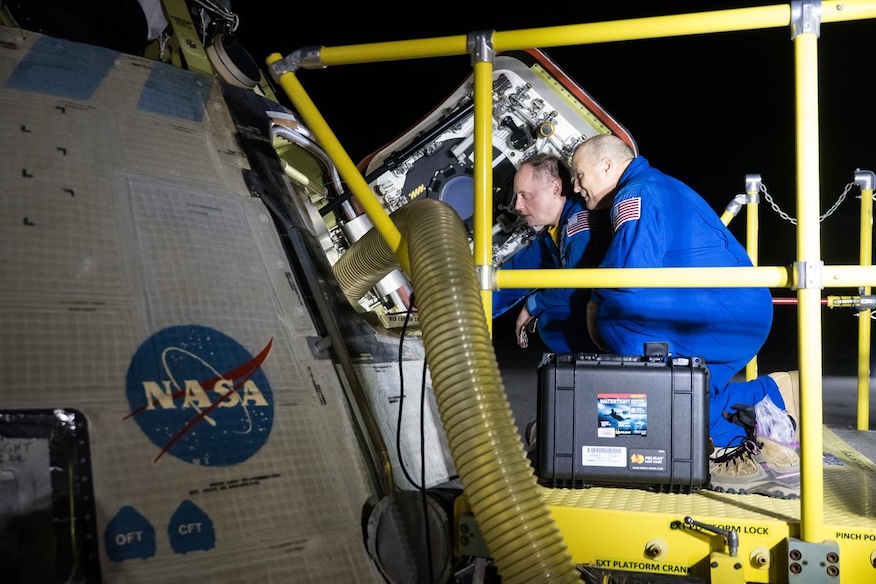
The most recent formal assignment to the Starliner-1 mission came on Nov. 22, 2023, when Kutryk was named as a mission specialist. He went on to serve as the Capsule Communicator (CAPCOM) for the CFT mission.
Like with NASA, following the Crew-11 announcement, Spaceflight Now also reached out to CSA regarding Kutryk’s status in connection with the Starliner-1 mission. And like with NASA, a CSA spokesperson declined to confirm his crew assignment.
“The Canadian Space Agency and NASA continue to evaluate future assignments to ensure the respective agencies accomplish their human spaceflight goals,” a CSA spokesperson said. “In the meantime, Joshua Kutryk continues his mission-specific training at NASA’s Johnson Space Center.”
As of Friday afternoon, the CSA website still has a page outlining the Starliner-1 mission and its now potentially former crew. Kutryk’s CSA astronaut bio also lists his upcoming mission as Starliner-1.
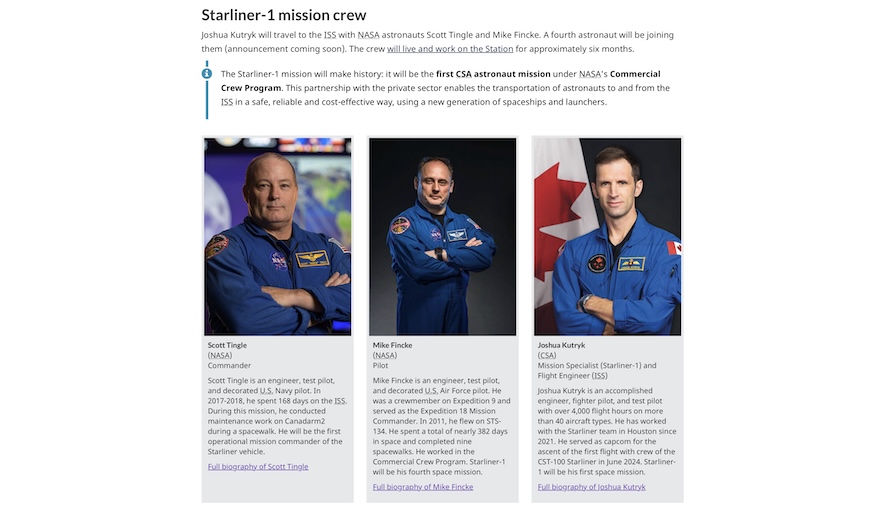
Stay Informed With the Latest & Most Important News
Previous Post
Next Post
-
 012024 in Review: Highlights from NASA in Silicon Valley
012024 in Review: Highlights from NASA in Silicon Valley -
 02Panasonic Leica Summilux DG 15mm f/1.7 ASPH review
02Panasonic Leica Summilux DG 15mm f/1.7 ASPH review -
 03How New NASA, India Earth Satellite NISAR Will See Earth
03How New NASA, India Earth Satellite NISAR Will See Earth -
 04And Thus Begins A New Year For Life On Earth
04And Thus Begins A New Year For Life On Earth -
 05Astronomy Activation Ambassadors: A New Era
05Astronomy Activation Ambassadors: A New Era -
06SpaceX launch surge helps set new global launch record in 2024
-
 07Space Force plans new ‘Futures Command’ amid pressure to speed up modernization
07Space Force plans new ‘Futures Command’ amid pressure to speed up modernization













